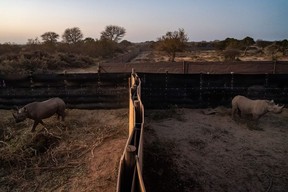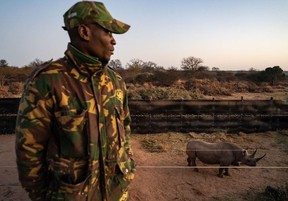To save rhinos, conservationists are removing their horns -- and a study finds it's working
Dehorning reduced poaching by 78 percent over a seven-year period

Article content
Conservationists are increasingly turning to a method of protecting the world’s diminished population of rhinoceroses: Removing their horns before poachers can get their hands on them.
A study published Thursday in the journal Science found that dehorning – a conservation practice that involves sedating the often multi-ton animals, covering their eyes and ears, and trimming their horns, which do not have nerves and grow back in a few years – reduced poaching by 78 percent over a seven-year period in eight reserves across 11 studied in South Africa, home to most of Africa’s rhinos.
Whereas costly surveillance and law enforcement often prove futile in a vast, tangled landscape of criminal syndicates, corruption and wealth inequality around South African reserves, conservationists and researchers say, dehorning appears to be more impactful – but should remain a measure of last resort rather than a long-term solution.
The researchers are far from blind to the implications of removing the most iconic body part of a charismatic species that has captured global interest for generations.
“Is a rhino still a rhino without its horns?” asked Timothy Kuiper, the study’s lead author, a senior lecturer in conservation and statistics and South Africa’s Nelson Mandela University.
“The horns are such a distinctive part of its anatomy, it’s a beautiful part of its body,” he said. “It’s wonderful to see a rhino with its horn.”
Kuiper called dehorning “a necessary evil.” Vanessa Duthé, an ecologist who has studied biological effects of dehorning, called it a “pragmatic, and, at times, essential tool” that removes the assets criminals are going for in high-risk poaching areas.

There are fewer than 28,000 rhinos in the world, a steep drop from 500,000 at the start of the 20th century, according to the International Rhino Foundation, a conservation group. The majority are from two species in Africa: Black rhinos are critically endangered (6,500 left), and white rhinos are considered near threatened (16,800), according to the World Wildlife Fund. Three other species live in Asia, with two kinds – the Javan and Sumatran rhino – each having fewer than 50 animals left alive.
African rhinos are targeted by poachers who kill them to cut off their horns, which are displayed as a status trophy or consumed as an element of traditional Chinese medicine. A kilogram of rhino horn at its peak went for $65,000.
An estimated 12,713 rhinos have been poached in Africa since 2006, the majority in South Africa, according to conservation charity Save the Rhino. Five hundred and eighty-six African rhinos were poached in 2023, the International Rhino Foundation found. More than 300 of those were killed in just one state-run park.
“You can catch a poacher and there’s three standing in line to take his place,” said another researcher behind the study, Rhino Recovery Fund Director Markus Hofmeyr.

Dehorning was the only practical anti-poaching intervention for which the researchers found strong evidence of effectiveness, and it is much more cost-effective than other methods such as 24/7 patrols.
Over the seven-year study period, the reserves dehorned 2,284 rhinos. Reducing poacher incentives through dehorning achieved “large and abrupt” reductions in kills, while using just over 1 percent of the reserves’ $74 million anti-poaching budget, the study found.
The researchers estimated a “13% risk of an individual horned rhino being poached in a particular year compared with a 0.6% poaching risk for a dehorned rhino.”
Between 70 and 134 rhinos were saved from poaching in the 12 months after dehorning, the study said. The median cost to save a rhino was $7,133 per rhino.
Dehorning itself “is quite an operation, logistically,” Kuiper said. But it doesn’t include pain for the rhino, researchers say – their horns are made mostly of keratin, the same material as human fingernails.
Usually, a helicopter is involved, to locate the rhino. A team is deployed, often driving off-road, to reach the animal. A qualified veterinarian and a team immobilize the rhino with drugs. The horn is removed with a chain saw, Kuiper said.
Once off, the horns are held in stockpiles in secure, secret locations, according to researchers.

There is ongoing debate about legalizing the international rhino horn trade. Some argue that harvesting horns at regular intervals might satisfy demand while contributing to rhino protection funds. Others say it could increase poaching and demand – a grave risk with so few rhinos left.
Dehorning “is not a silver bullet,” Kuiper said.
Some poachers have even killed dehorned rhinos for their regrowing stumps. Veterinarians can only cut up to the growth plate, which has nerves and blood vessels, leaving 5 to 15 centimeters of horn.
Over two years, the researchers recorded the poaching of more than 100 previously dehorned rhinos – some just weeks after the procedure, Kuiper said.
Horn demand, including for trophies and use in traditional medicine, along with poverty and the presence of criminal gangs, drives poaching. But researchers add that entrenched corruption – including between police, reserve staff and courts – has skewed the cost-benefit analysis for criminal poachers. There are cases of repeat offenders, too.
“It’s a kind of perfect storm of criminal syndicates to come in and recruit people who are vulnerable socioeconomically,” Kuiper said.
In remarks last month, South Africa’s forestry minister, Dion George, praised the efforts of law enforcement. “Our rangers are the true heroes in this fight, risking their lives daily to protect our rhinos,” he said. George has also praised the potential of dehorning programs, in combination with other methods of protection.
The practice of dehorning, initially tried decades ago, is growing. Across southern and eastern Africa, you can see more and more rhinos “in a dehorned state,” Kuiper said.
Rhinos can survive and breed without their horns, but at least some researchers have raised questions about behavioral effects.
A 2023 study found that dehorned black rhinos decrease their home ranges. The theory is that dehorned rhinos might be less bold without them.
Duthé, that study’s lead researcher, said by email that while there are measurable changes in movement and social patterns, current evidence shows no impact on population growth rates. The known effects are “generally considered acceptable when weighed against the significant reduction in poaching,” she said.
“A live rhino without a horn, because you’ve cut it off, is a lot better than a dead rhino without a horn,” said Nina Fascione, IRF’s executive director.
The IRF supports dehorning, but not as a stand-alone, end-all technique. “You can’t just dehorn a rhino and then think they’re safe, because the poachers will go after it even for a little nub of a horn,” Fascione said.
Rhinos have probably changed little for at least the past million years, Hofmeyr said. By sheer size and strength, they have been able to successfully breed and survive.
That they are an evolutionary marvel is also a liability. They have not shown an ability to rapidly adapt to human threats – such as how elephants know not to return to a watering hole where one of the group has been shot, he said.
“You can kill every last rhino in the landscape if you know … where they drink, the way they walk” – and how to evade law enforcement, Hofmeyr said. “You can shoot the rhinos at the same waterhole until the very last one is gone.”
It’s a “symbol of us as a human species,” he said, that we cannot take responsibility for “keeping something alive that has actually been much more successful than we’ve ever been” at surviving on our own.











Postmedia is committed to maintaining a lively but civil forum for discussion. Please keep comments relevant and respectful. Comments may take up to an hour to appear on the site. You will receive an email if there is a reply to your comment, an update to a thread you follow or if a user you follow comments. Visit our Community Guidelines for more information.